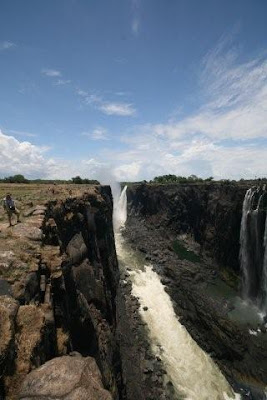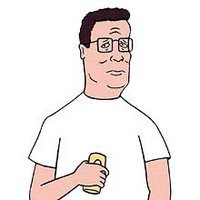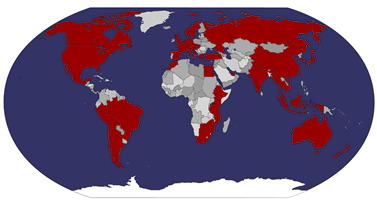It’s a short drive to the border, where first we clear Botswanan immigration, then to Zimbabwe.

The flag outside the office looks a bit tattered, but I don’t take a photo without permission – and when I ask inside, I’m told this is not allowed. Anyway, British and Irish nationals have special prices for visas. It’s 30US$ for most countries, but 55US$ for us! The Robert Mugabe Special Visa! Their exchange rates are clearly a little out of date though, as the price is 35 UK pounds (about 72US$) or 55US$! Dollars it is then!
The full page stamp is definitely a good one to have in the passport.

This done, we drive on, and it’s about 70km to the falls along a fairly good road. At the side is the Zambezi National Park, I presume we’re not all that far away from the river.

Along the way, we come across a couple of elephants. They are flapping their ears to keep cool.

In town, we pass the commercial centre, where there is a Wimpy, Barclays, and a few other shops, and park up near the park entrance. I notice that Barclays has two ATMs, one for the local and largely useless currency, and one for hard, i.e. US dollar, currency. There is an artificially high peg rate for their Zimbabweian dollars – so basically there is the official government rate for things, then the real price, and as a tourist you’re expected to juggle between the two.
Like Iguassu in South America, Victoria Falls span an international border, here Zambia and Zimbabwe. In practical terms here, Zambia has the actual falls themselves, whereas Zim has the views of them. We head into the Victoria Falls National Park, paying the 20US$ entry fee. Apparently if there’s going to be a full moon, one can pay 40US$ to stay late, and see a lunar rainbow.

I couldn’t possibly
So, the history is that David Livingstone discovered the falls [GPS:17.925292S, 25.857611E] on 16th November 1855. He named them after Queen Victoria, and wrote "No one can imagine the beauty of the view from anything witnessed in England. It had never been seen before by European eyes; but scenes so lovely must have been gazed upon by angels in their flight."

Dave L I presume?

At this end of the falls, you can see the Zambezi, calm before plummeting down the falls. There’s supposedly good fishing here.

Saving the fish from the jump
The first part (as we cross from West to East) is called Devil’s Fall.

We march down the Cataract Steps, which are dripping wet with all the spray they are receiving.

Down we go
At the bottom there’s a nice view across the main falls, which are supposed to form the largest single sheet of waterfall in the world.

Wet down here
Passing a plague which also has the original tribal name for the falls, we approach the main falls.

Victoria Falls, or Mosi-oa-Tunya (the smoke that thunders)

The main falls

More spray in the face

Marvellous
There is supposedly plenty of wildlife about too, not that we see any!

The path
We are viewing the falls roughly at the same pace as a large group of school children. Chatting with their teachers, I find out they are from Bulawayo, which is across the border from Francistown, and had come up by train, an option I also considered originally. The teacher was lamenting the fact that due to the economy many parents couldn’t afford even the modest cost of sending their child on this trip.

Pesky kids
This part of the falls is calld the Cataract, and has an island sitting above it called Livingstone Island, where he first arrived in a canoe to view the falls.

The other side, which is Zambia, we can see some tourists swimming just in front of the falls! What a marvellous place to have a dip. No such luck on this side.

Dry
Supposedly this long run of basalt rock is covered with waterfalls during the wetter seasons.

Looking back

Rainbow

The kids’ photographer asks me to take his photo.

Photographer wants a photo
I suppose ideally one would visit the falls from both sides, as with Iguassu in Brazil and Argentina. For the best overall view, this side is definitely better, and it’s great that you have such a close view of the falls – we’re about 60m away across the gorge, and the falls are 108m high.

The last spot, Danger Point, is a good one for a rest. It’s hotting up now. We can see some rafters down below about to set off.


The kids pose for group photo before heading off for their train home.


No, I am not stepping backwards
Anthony picks us up next and takes us to the Ronseal-named Big Tree. Apparently this is where Livingstone was last sighted before he went missing.
The Big Tree

This done, we pop into the Victoria Falls Hotel, the best hotel in town, a gorgeous colonial job which is slightly out of my price range for this trip at 300US$ per night.


My kind of hotel

A classic journey

The view from the patio
Then as none of us want to do any shopping, we head back, watching as large storm clouds gather and head towards us, arriving just as we get back to Botswana.

Downpour
So I ended up being stuck in the hotel all afternoon, finishing the night with some rum with Walter, the Spanish owner who is full of interesting stories from his well-travelled life. The next morning – a 6:30am bus back to Francistown, connecting with another to Gabs. 12 glorious hours of bus fun, with no mobile phone as the networks were knocked out for at least a day by the thunderstorms! Bring it on, I’ve been to India, buses don’t frighten me any more!
The Evils of Robert Mugabe
There is plenty in the press about the dire straits in Zimbabwe recently. Here’s a summary of recent history, most pinched from Lonely Planet’s history):
Zimbabwe as it is now called was formed and named Rhodesia after Cecil Rhodes, with the capital at Fort Salisbury (Harare). The country was developed by and ruled by a white government which discriminated against the indigenous people. This came to an end in 1980, with independence, and when Robert Mugabe became Prime Minister. This was when the country was renamed Zimbabwe. Soon afterwards, in order to secure his power, Mugabe sent in North-Korean-trained troops to the heartlands of rival party areas to slaughter tens of thousands of civilians, sometimes entire villages. Approaching 2000, it seemed that support for Mugabe was waning, so he responded by waves of intimidation, violence, and his highly destructive land reform programme. Even with all of this, he only just scraped through.
By the next election, in 2005, he had made sure that there would be no risks. In the five years, he closed and even bombed newspapers, the state controlled newspaper, tv and radio, voters were bought with food (and threatened with no food), the leader of the opposition, Morgan Tsvangirai, went through two treason trials, and up to a million ghost voters were created on the electoral role. Not only did he win with a majority, he made sure it was of the two-thirds required to change the constitution to ensure he controlled succession.
Land Reform
Land reform was certainly necessary in Zimbabwe – prior to 2000, 70% of the best land was owned by 4,000 white farmers. What was definitely wrong were Mugabe's motives for his actions, and the way he went about it. He was playing the race card, furious that the white farmers had supported the opposition parties in the elections, plus with the economy in trouble, so he hoped to win over the peasant majority by grabbing land back and redistributing it. However, Mugabe was interested in maintaining power, not equality for the people. Hundreds of black farmers were killed, along with scores of whites. Land was given to government ministers, party faithful and foreign friends.
Some genuine new farmers attempted to work their land, though seed, fuel and fertiliser shortages meant their efforts failed. Others simply stole crops, stripped out houses, and removed machinery and irrigation systems then fled, leaving millions of acres of land idle.
In May 2005, the government began a house destruction programme, knocking down homes and buildings in urban centres, locking up people and particularly targeting the poor. The operation was named Murambatsvina (“Kick out the trash”). Mugabe said he wanted people to return to their rural homes, and to clean up “a chaotic state of affairs” in the informal sector. The general theory though is that after revolutions in Ukraine and Georgia, his dictatorship government was making a pre-emptive strike against densely populated areas that opposed his rule. By de-urbanising cities, the government could move people to rural areas where they controlled food supplies, and therefore votes. The UN said the operation left the country “deeper in poverty, deprivation and destitution”. It was, said the UN, “the worst possible thing at the worst possible time”.
What does the future hold? No one seems to have much hope. I think the key is that the African Union, in particular Zim's neighbouring countries - South Africa especially - need to exert more pressure and insist on change. At the moment they are being too weak and ignoring what is going on on their own doorstep.
There are millions of Zimbabwean refugees in Botswana, South Africa, the UK and elsewhere. I just hope that things improve so that, as they’ve said to me, they can return home to their beautiful country, and we, as tourists, can visit Zimbabwe once again.




No comments:
Post a Comment